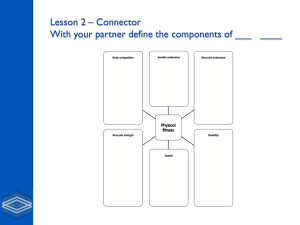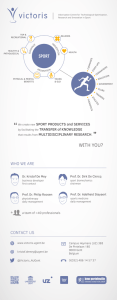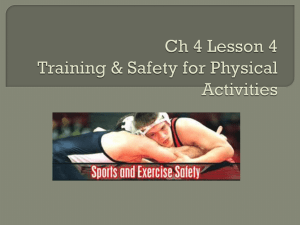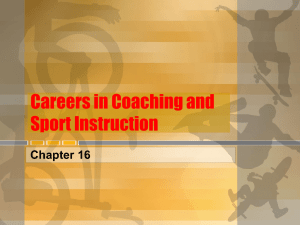National Standards for Physical Education
advertisement
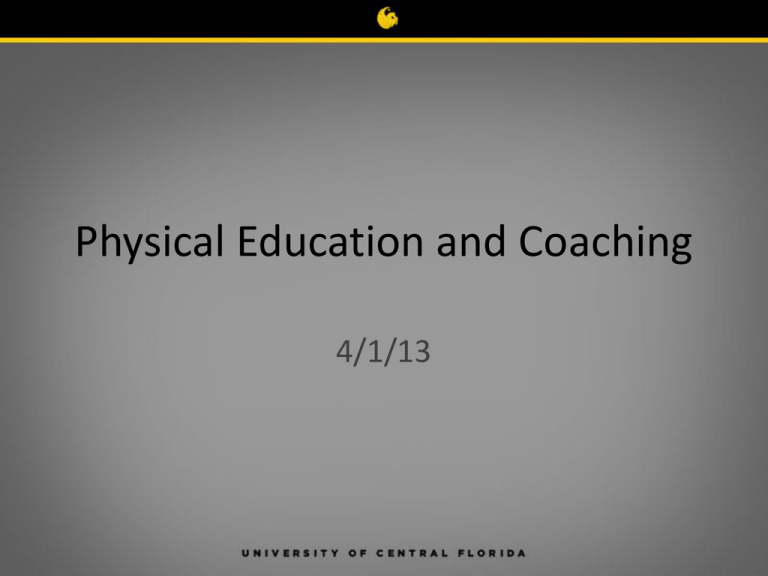
Physical Education and Coaching 4/1/13 Sport Pedagogy Definition • Sport pedagogy is concerned with the study of teaching and learning processes of physical activity. • Emphasis is placed on curriculum and instruction (i.e., teaching) and teacher education . • Quality physical education programs focus on increasing physical competence, health-related fitness, selfresponsibility, and enjoyment of physical activity for all students so that they can be physically active for a lifetime. • Sport pedagogy – is it the overarching field of physical movement or one of the subdisciplines? 3 Historical Development • Sport pedagogy emerged as a specialized area of study in the 1960s. • Sport pedagogy traces its roots from the prehistoric times of Ancient Greece and Rome (B.C.) and the early modern European ‘gymnastics’ programs of Germany, Sweden, and Great Britain in the 1700s and 1800s. • 1970s - doctoral programs were established and began to produce teacher educators in physical education . 4 Historical Development • Scholars such as William Anderson, Daryl Siedentop, Ann Jewett, John Cheffers, and Larry Locke conducted descriptive-analytic research that used systematic observation instruments to describe events and the interactions between teachers and students PE classes. • In 1975, the American Alliance for Health, Physical Education, Recreation, and Dance (AAHPERD) created the National Association for Sport and Physical Education (NASPE) and formulated the Curriculum and Instruction Academy. • 1980s - research articles were being published in journals such as Research Quarterly for Exercise and Sport, Quest, and the Journal of Teaching in Physical Education. 5 Standards-based Education • The national standards movement was not a quest to develop a national curriculum; rather, the charge was to formulate educational goals for the nation on ‘what students should know and be able to do’. • Goal: decrease the achievement gap between the economically advantaged and disadvantaged, whites and minority students, immigrant children, and students with disabilities. • In 2001, federal legislation proposed a new educational initiative, No Child Left Behind (NCLB) Act, to narrow the achievement gap . 6 No Child Left Behind Act • Mandates for greater accountability for student learning. • Goal: to have every child attain proficiency in reading and mathematics. • Four principles: – Stronger accountability for results – More freedom for states and communities – Proven education methods – More choices for parents 7 NASPE Standards in Physical Education • Moving into the Future: National Standards for Physical Education: A Guide to Content and Assessment (1995, 2004). • Provide a framework for student learning “what a student should know and be able to do as a result of a quality physical education program”. • Assessment – PE Metrics, NASPE Assessment Series. 8 Curriculum Development • A PE curriculum “includes all knowledge, skills, and learning experiences that are provided to students within the school program”. • National standards is the focal point and the activity the medium through which instruction was delivered for students to achieve performance outcomes. • What were your physical education programs like at the elementary, middle, and high school levels? • How did your teacher deliver the instruction? • What did you learn in physical education, and how do you know if you learned? 9 Curriculum Development • Unit of instruction (e.g., basketball, dance) incorporates all of the goals, objectives, content (i.e., tasks, activities, key terms and concepts), instructional materials, and individual lessons. • Lesson plan is a specific outline of all of the objectives, tasks, and assessments that will be included for one particular lesson. 10 11 Changes in Physical Education Content • Standards • Teachers’ philosophies of PE • Geographic location • School and program context (e.g., facilities, equipment, class size) • Time 12 Curriculum Models • A teacher’s philosophy along with program goals and objectives, influence the focus of instruction. • Curriculum models are focused, theme-based, and represent a particular philosophy. • There is not a ‘one size fits all’ model for all content taught in physical education. 13 Skill-Themes Approach • 4 phases in the skill themes • Developmental model that approach: originates from Great Britain; – Basic Skill – mastery and achievement based on Ralph Laban’s movement of the critical elements of the skill according to the age and analysis framework from the developmental level of the students. 1940s. • 1980, Graham, Holt/Hale, McEwen and Parker, modified the framework and developed the skill themes approach. • Movement skills and concepts in games, sports, gymnastics, and dance are the basis of this model. – Combinations – once the basic skills and critical elements are mastered, other skills and movement concepts can be added. – Skill in Contexts – Skills, movements, and combinations are performed in a variety of contexts. – Culminating Activity – As skills and concepts progress through phases 1, 2, and 3, the application of the skill occurs in different content areas within games, sports, gymnastics, and dance. 14 Personal & Social Responsibility Model (PSRM) • Focuses on the development of • Teachers and students can the whole student, including assess their personal and how students think, feel, and social responsibility based interact with others. • Embraces students as individuals, provides them with a voice, allows them to make decisions on their own, and places less emphasis on skill development and academic achievement. on five different levels: – Level I – Respecting the rights and feelings of others – Level II – Participation and effort – Level III – Self-direction – Level IV – Caring about and helping others – Level V – Outside of the 15 gym Teaching Games for Understanding (TGfU) Tactical Games Model (TGM) • Problem-based approach to games teaching. • 1980’s - Thorpe and Bunker developed TGfU; based on modified game play that set up tactical problems for students to solve. • 1997, Griffin, Mitchell, and Oslin revised TGfU into the Tactical Games Model (TGM). • Goal of TGM - improve students’ game performance by combining tactical awareness with skill execution and increase students’ interest and excitement about games. 16 Sport Education Model (SEM) • Developed by Daryl Siedentop in 1984. • Purpose - create an authentic sport experience and educate and develop students to be competent, literate, and enthusiastic sportspersons. • The main features of the model include: seasons, team affiliation, formal competition, record keeping, culminating event, and festivity. 17 Fitness Education • Can include units on the healthrelated components of fitness, walking or hiking, or weight training. • Concepts-based Fitness and Wellness Model – Students engage in classroom discussions, laboratory activities, and physical activity experiences. – Goal - for students to learn how to develop and execute their own physical activity programs that they can participate in and out of school. 18 Adventure Education • Allows students to learn about themselves and their peers as they take on individual and group tasks and challenges. • Teachers act as facilitators as students collaborate and problem-solve with one another to accomplish a task. • 3 Essential Practices: – Experiential Learning Cycle – Full Value Contract – Challenge by Choice • Project Adventure - based on 5 philosophical concepts, which include: challenge, cooperation, risk, trust, and problem-solving. 19 Outdoor Education • What activities come to mind when you think of outdoor education? • Occurs in the natural setting, where teachers and students have little to no control over the environment and potential hazards that may arise. • Emphasis placed on skill development. • Cost can be a factor for equipment. 20 Cultural Studies Curriculum in Physical Activity and Sport • Emphasizes students’ development as “literate and critical consumers of sport, physical activity, and the movement culture”. • Goal - for students to be able to observe, analyze, and critique physical activity and sport issues and topics in a variety of contexts. • Learning experiences occur both in the classroom and the gymnasium. • Mostly implemented in New Zealand, Australia, England. 21 22 Assessment & Accountability • Salient component needed to measure whether students have learned and are achieving the national standards. • Holds physical education programs and teachers accountable for student achievement. • Instructional Alignment - connecting the standards, instruction, and assessment components of physical education curricular and units of instruction. 23 24 Characteristics of Effective Teaching • Use a variety of pedagogical skills and strategies to: – Ensure that their students are appropriately engaged in relevant activities a high percentage of the time – Hold positive expectations for their students – Create and maintain a classroom climate that is warm and nurturing. • Salient teacher behaviors can be divided into several broad areas: organization, communication, instruction, motivation, and human relations. 25 26 Student Perspectives • Voice • Choice • Responsibility • Goal – for students to feel a sense of ownership and empowerment in their learning experiences. 27 Differences & Diversity in Physical Education • Thinking back to your K-12 physical education classes, reflect upon the following questions: – Were athletes and higher skilled students given special privileges? – Did students with disabilities participate with the rest of the class or were they off to the side, away from the action? – Were girls and boys treated the same? – Did teachers have high expectations for all students, regardless of race? 28 The ‘Hidden Curriculum’ • Based on unintended and implicit messages that are inferred by teachers and learned by students. • Few PE teachers explicitly educate their students about gender, sexuality, race, and class issues. • Many students and teachers feeling isolated, oppressed, and marginalized. • Physical educators have the potential to introduce and educate students to the ideas of privilege, oppression, and power relations. 29 Social Identities in Physical Education • (Dis)ability • Gender • Body issues • Race • Class • Sexuality 30 Teaching and Coaching Careers in Physical Education and Sport Chapter 12 Teaching and Coaching Careers • What are the advantages and disadvantages of pursuing a teaching career? • What are the similarities and differences between teaching and coaching? • What is the effect of burnout on teachers and coaches? 32 Benefits & Drawbacks Drawbacks Benefits Salary Teach diverse activities Offers job tenure Intrinsic rewards Opportunity to coach Lack of financial support Inadequate facilities Discipline problems Overpopulated classes Non-subject related duties (lunch duty, etc.) 33 Benefits & Drawbacks Non-school Setting Benefits Clients are voluntary Opportunity to specialize in an area Variety of settings Drawbacks Lack job security Various work hours Salary could be dependent on number of clients 34 NASPE Beginning Teacher Standards • Content knowledge • Growth and development • Diverse learners • Management and Motivation • Communication • • • • • Planning and Instruction Learner Assessment Reflection Collaboration Technology 35 High Quality Programs (NASPE) • Help students develop health-related fitness, physical competence, and cognitive understanding of the many different facets of physical activity. • Focus on meeting the developmental needs of students and developing the skills, knowledge, and attitudes essential to adopting a healthy and physically active lifestyle • Essential features – opportunity to learn – incorporation of meaningful content – appropriate instruction. 36 Conducting Quality Programs • Opportunity to learn – Qualified, physical education specialists who can skillfully implement developmentally appropriate physical education program – Sufficient instruction time • 150 minutes/week elementary level • 225 minutes/week middle and high school level – Adequate facilities and equipment 37 Conducting Quality Programs Meaningful content sequenced and organized Variety of motor skills Fitness education Enhancement of learning in three domains Helps students incorporate regular physical activity into their lives 38 Conducting Quality Programs • Provision of appropriate instruction • Inclusion of all students in developmentally appropriate physical activity • Physical activity is valued for it’s contribution to health and life • Assessment of student learning conducted on a regular basis 39 Developmentally Appropriate Physical Activity Experiences • Curriculum • Development of movement concepts and fundamental skills • Cognitive development • Affective development • Concepts of fitness • Physical fitness tests • Calisthenics • Fitness • • • • • • • • • Assessment Regular involvement Active participation Activities Equity Success rate Time Facilities Equipment 40 Teaching Responsibilities • Instructional Tasks (related directly to teaching) – Explaining or performing a skill, or strategy, and evaluating students’ performances. • Managerial Tasks (related to the administration of class) – Taking attendance, dealing with discipline problems, supervising the locker room, handling equipment. • Institutional Tasks (related to the setting in which teaching occurs) – Hall duty, lunch room supervision, attend curriculum and department meetings, conduct parent-teacher conferences. 41 Teaching Careers School Setting • PreK-12 (public or private) • Higher education – Basic instruction – Professional Preparation • Adapted physical education Non-School Setting • Clubs • Community organizations • Centers for the elderly • Resorts • Military 42 Teaching Certification • Each state has minimum requirements that prospective teachers must reach before they become legally certified to teach. • Complete standardized tests – general knowledge – communication skills – professional knowledge – specialty area (physical education or health, etc.) • Public schools require certification, but private and non-school settings may not. 43 Adapted Physical Education National Standards • • • • • • Human development Motor behavior Exercise science Measurement & evaluation History & philosophy Unique attributes of learners • Curriculum theory and development • Instructional design & planning • Teaching • Consultation & staff development • Student & program evaluation • Continuing education • Ethics • Communication 44 Coaching Responsibilities Instructional: conducting practice, coaching a game Managerial: recording statistics, dealing with equipment, giving interviews, recruiting Institutional: teaching or department duties/meetings Represent organization Counseling athletes Professional development at clinics/conventions 45 Benefits and Drawbacks of Coaching Drawbacks Benefits Intrinsic rewards Excitement of winning Respect Satisfaction of giving one’s best Help athletes learn Long hours Salaries vary greatly High turnover rate Pressure to win Role conflict Burnout Security 46 Securing a Coaching Position • Requires expertise gained through: – Playing experience – Attending clinics and workshops – Being an official in your sport – Taking advantage of certification/licensing programs • May require teaching certificate or master’s degree • Consider gaining expertise in a second sport to increase marketability. • Gain practical experience. 47 NASPE Domains of Coaching Competency Philosophy and ethics Safety and injury prevention Physical conditioning Growth and development Teaching and communication Sports skills and tactics Organization and communication Evaluation 48 Coaching Certification Programs • American Sport Education Program (ASEP) – Training in coaching the young athlete, coaching principles, sports first aid, drugs and sport, and teaching sport skills. • National Youth Sport Coaches Association (NYSCA) • Program for Athletic Coaches Education (PACE) 49 Burnout • Defined: Overwhelming exhaustion, feelings of cynicism and detachment from the job, and a sense of ineffectiveness and lack of accomplishment. • Causes: – Lack of administrative and community support – Lack of input – Inadequate salaries for large teaching loads – Large classes, discipline problems – Absence of opportunities for professional and personal growth – Teacher-coach role conflict – Professional and personal problem interaction 50 Burnout • Prevention and remediation – Provide meaningful in-service programs – Increased feedback about performance by administration – Participation in professional organizations – Revitalize oneself on time off with hobbies or nonwork related activities – Maintain good health 51 Increasing Professional Marketability Build on skills and talents Need for bilingual educators. Additional coursework Adapted physical education Dual certification Become certified to teach more than one subject or even driver education. Practical experience Join professional organizations and network. Demonstrate use of technology 52 Presentation Pointers Basic suggestions http://www.youtube.com/watch?v=AykYRO5d_l I Rubric • Dress – Dress how you want to be perceived – If you want to be perceived as an individual that is intelligent, and knowledgeable on the subject, dress professionally. Rubric • Preparation/Understanding – The more you prepare, the better you will understand the material – Remember if you rehearse the presentation, you will likely be faster when you actually do it – With proper preparation and understanding of the material, delivery will be improved Rubric • Delivery – SPEAK CLEARLY, and PROJECT!!! – Say what you mean, and mean what you say, if you make a mistake, move on Rubric • Power Point – Golden Rule: One slide per minute (on average) – This can very greatly based on • Individual • Topic • How much is on each slide – Try to limit the number of words on your slides, they can be distracting Rubric • Questions – Have a broad understanding of the topic, beyond what your focus entails to properly handle and answer questions. • Time – 15-20 minutes – This is a rather wide range, be sure you stay inside of it Rubric • Power Point Citations – This are inside the presentation itself – Must include the author, title, journal and year • Works Cited Page – Use the JSCR guidelines for citations – http://edmgr.ovid.com/jscr/accounts/ifauth.htm Citations • Journal Article – Hartung, GH, Blancq, RJ, Lally, DA, and Krock, LP. Estimation of aerobic capacity from submaximal cycle ergometry in women. Med Sci Sports Exerc 27: 452–457, 1995. • Book – Lohman, TG. Advances in Body Composition Assessment. Champaign, IL: Human Kinetics, 1992. • Chapter in an edited book – Yahara, ML. The shoulder. In: Clinical Orthopedic Physical Therapy. J.K. Richardson and Z.A. Iglarsh, eds. Philadelphia: Saunders, 1994. pp. 159–199. Questions? This is your time to work, first groups present next week, make sure you and your group are ready…


